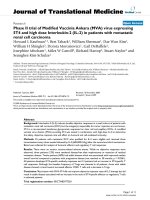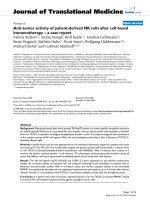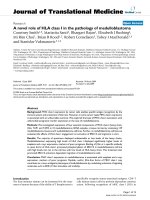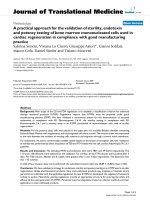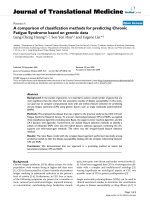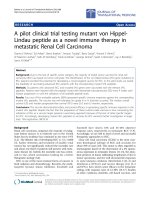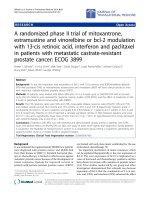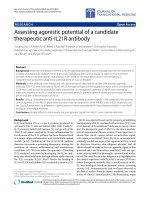báo cáo hóa học: " A randomized trial of a lifestyle intervention in obese endometrial cancer survivors: quality of life outcomes and mediators of behavior change" pptx
Bạn đang xem bản rút gọn của tài liệu. Xem và tải ngay bản đầy đủ của tài liệu tại đây (231.55 KB, 9 trang )
BioMed Central
Page 1 of 9
(page number not for citation purposes)
Health and Quality of Life
Outcomes
Open Access
Research
A randomized trial of a lifestyle intervention in obese endometrial
cancer survivors: quality of life outcomes and mediators of behavior
change
Vivian E von Gruenigen*
1,2
, Heidi E Gibbons
1,2
, Mary Beth Kavanagh
3
,
Jeffrey W Janata
1,2,4
, Edith Lerner
3
and Kerry S Courneya
5
Address:
1
University Hospitals Case Medical Center, Cleveland, OH, USA,
2
Department of Reproductive Biology, Case Western Reserve University,
Cleveland, OH, USA,
3
Department of Nutrition, Case Western Reserve University, Cleveland, OH, USA,
4
Department of Psychiatry, Case Western
Reserve University, Cleveland, OH, USA and
5
Department of Physical Education and Recreation, University of Alberta, Edmonton, AB, Canada
Email: Vivian E von Gruenigen* - ; Heidi E Gibbons - ;
Mary Beth Kavanagh - ; Jeffrey W Janata - ; Edith Lerner - ;
Kerry S Courneya -
* Corresponding author
Abstract
Background: To examine the effects of a 6 month lifestyle intervention on quality of life,
depression, self-efficacy and eating behavior changes in overweight and obese endometrial cancer
survivors.
Methods: Early stage endometrial cancer survivors were randomized to intervention (n = 23) or
usual care (n = 22) groups. Chi-square, Student's t-test and repeated measures analysis of variance
were used in intent-to-treat analyses. Outcomes were also examined according to weight loss.
Results: Morbidly obese patients had significantly lower self-efficacy, specifically when feeling
physical discomfort. There was a significant improvement for self-efficacy related to social pressure
(p = .03) and restraint (p = .02) in the LI group. There was a significant difference for emotional
well-being quality of life (p = .02), self-efficacy related to negative emotions (p < .01), food
availability (p = .03), and physical discomfort (p = .01) in women who lost weight as compared to
women who gained weight. Improvement in restraint was also reported in women who lost weight
(p < .01).
Conclusion: This pilot lifestyle intervention had no effect on quality of life or depression but did
improve self-efficacy and some eating behaviors.
Trial Registration: ; NCT00420979
Background
Endometrial cancer is the most common gynecologic can-
cer in the United States and obesity is the most significant
risk factor for development of the disease [1]. A recent
prospective study reported that 68% of women with early
endometrial cancer were obese which is markedly
increased compared to older reports [2-5]. Adding to this
escalation is the increased rate of obesity in the female
Published: 25 February 2009
Health and Quality of Life Outcomes 2009, 7:17 doi:10.1186/1477-7525-7-17
Received: 17 September 2008
Accepted: 25 February 2009
This article is available from: />© 2009 von Gruenigen et al; licensee BioMed Central Ltd.
This is an Open Access article distributed under the terms of the Creative Commons Attribution License ( />),
which permits unrestricted use, distribution, and reproduction in any medium, provided the original work is properly cited.
Health and Quality of Life Outcomes 2009, 7:17 />Page 2 of 9
(page number not for citation purposes)
population (18.1%) [6]. When assessing obesity associ-
ated cancers, it appears that endometrial cancer patients
are the most morbid as most have stage I disease yet are at
significant risk for premature death [7]. While the impact
of weight on cancer recurrence does not appear to be a fac-
tor in endometrial cancer, obese endometrial cancer sur-
vivors have a higher mortality from causes not related to
cancer [8]. Endometrial cancer survivors have numerous
co-morbidities related to their obesity which include
hypertension (HTN), diabetes mellitus (DM), cardiovas-
cular disease (CVD), osteoarthritis (OA) and pulmonary
disease [5]. Improving medical co-morbidities through
weight management in survivors may lead to improved
overall quality of life and survival.
Differences in quality of life (QOL) between obese and
non-obese endometrial cancer survivors are related to
physical health. In a prospective examination of QOL,
general health status, and obesity in women with early
stage endometrial cancer, [9] women with a body mass
index (BMI) less than 30 (non-obese) had increased phys-
ical QOL scores. There was also an inverse relationship
between the global physical health composite score and
BMI; with higher BMI associated with a declining physical
QOL score. A recent cross-sectional survey of Canadian
endometrial cancer survivors revealed that those patients
with morbid obesity had a QOL score three times lower
than women with a normal BMI [10]. This suggests that if
weight is decreased, survivors QOL may be improved.
What is unknown is the effect a survivorship lifestyle
intervention trial may have on QOL, psychological health
and eating behavior.
We have previously reported the effects of a six-month
lifestyle intervention on weight loss, exercise behavior,
and nutrient intake changes in overweight and obese
endometrial cancer survivors [11]. We found that a life-
style intervention program in obese endometrial cancer
survivors is feasible and efficacious – resulting in sus-
tained behavior change and weight loss over a one year
period. The present query was conducted in order to
examine the intervention's effect on QOL outcomes,
depression, self-efficacy and eating behavior, possible
mediators of behavior change. We hypothesized that a
lifestyle intervention program would improve these out-
comes in obese endometrial cancer survivors. We also
conducted an exploratory analysis comparing women
who lost weight with women who gained weight.
Methods
Study Design & Patient Recruitment
The study was a prospective randomized controlled trial
comparing a lifestyle intervention (LI) consisting of exer-
cise and nutritional counseling with cognitive-behavior
modification to usual care (UC) in overweight and obese
endometrial cancer survivors. An invitation letter was sent
to women included in the cancer registry from the Ireland
Cancer Center at University Hospitals Case Medical
Center diagnosed with stage I-II endometrial cancer from
2001–2004. The 6 month intervention was delivered to
the LI group while the UC group received only an infor-
mational brochure outlining the benefits of proper nutri-
tion and physical activity. Institutional review board
approval was granted and informed consent and authori-
zation to use protected health information (HIPAA) was
obtained from all patients prior to study procedures. Fea-
sibility, eligibility criteria, and details of the intervention
have been published elsewhere [11]. Randomization
assignment was stratified by BMI (<40 versus ≥ 40). Prior
analysis revealed that demographics and clinical charac-
teristics were equivalent between groups [11].
Intervention Program
The counseling protocol was administered by the study
registered dietitian (RD), primary investigator (PI), and
psychologist. It followed a stepwise, phased approach
using strategies outlined by social cognitive theory, indi-
cating that the optimal intervention for a major behavior
change should focus on establishing short-term goals, and
enabling the person to build self-efficacy [12-16]. The
intervention covered topics related to nutrition and exer-
cise and met weekly for six weeks, biweekly for one
month, and monthly for 3 months. Participants were con-
tacted by the RD either by phone, email, or newsletter
every week that the group did not meet. The psychologist
met with the group during 2 of the 11 sessions and topics
included cognitive and behavioral self-management strat-
egies for weight loss and stress management. The PI met
with both LI and UC participants at 3, 6 and 12 months.
Measures
Patient demographic and clinical data was obtained at
baseline and prior to randomization. QOL and self-effi-
cacy were assessed at baseline and at 3, 6, and 12 months.
Eating behavior and depression was assessed only at base-
line and 12 months. QOL was measured by the Functional
Assessment of Cancer Therapy-General (FACT-G), a valid
and reliable questionnaire evaluating physical, func-
tional, family-social, and emotional well-being domains
[17,18]. A fatigue subscale (-F) and an endometrial symp-
tom subscale (-En) were also used [19,20]. Functional sta-
tus was measured with the SF-36, a comprehensive short-
form survey designed to measure functional health and
well-being [21].
Depression was measured by the Beck Depression Inven-
tory (BDI) which is well-validated and frequencly used in
lifestyle research studies [22]. Self-efficacy, an individual's
judgement regarding his/her ability to perform certain
behaviors, was measured with the Weight Efficacy Life-
Style (WEL) questionnaire. This scale specifically evalu-
ates self-efficacy judgments specific to eating behaviors in
Health and Quality of Life Outcomes 2009, 7:17 />Page 3 of 9
(page number not for citation purposes)
five situational factors: negative emotions, food availabil-
ity, social pressure, physical discomfort, and positive
activities [23,24]. This measure has evidenced adequate
psychometric properties, including internal consistency
coefficients ranging from 0.76 to 0.90 [23].
Eating behavior was measured by the Three-Factor Eating
Questionnaire (TFEQ), a self-assessment questionnaire
developed to measure cognitive and behavioral compo-
nents of eating [25,26]. Responses are aggregated into
three scales, cognitive restraint, disinhibition and hunger.
Cognitive restraint is designed to measure dietary
restraint, that is, control over food intake in order to influ-
ence body weight and body shape. Disinhibition meas-
ures episodes of loss of control over eating, while the
hunger scale is concerned with subjective feelings of hun-
ger and food cravings. Higher numbers reflect increased
restraint, decreased tendency to overeat in the presence of
disinhibitors (i.e. stress, mood, alcohol) and decreased
perception of hunger. All three subscales have demon-
strated high internal consistency and reliability [27,28].
Patient anthropometric data including weight, waist cir-
cumference, and BMI were measured at all time points
manually by the study dietitian. BMI was computed as
patient weight in kilograms divided by the square of their
height in meters. Participants were categorized according
to World Health Organization guidelines: < 18.5 (under-
weight), 18.5 to 24.9 (healthy weight), 25.0 to 29.9 (over-
weight), Class I – 30.0 to 34.9, Class II – 35.0–39.9, and
Class III or morbid obesity ≥ 40.0 kg/m
2
[29].
Statistical Analyses
Patient demographic, clinical variables and baseline val-
ues were compared between groups and by BMI (25.0 –
39.9 versus ≥ 40) by use of independent samples t-test or
chi-square test for proportions. Primary analysis used
repeated measures analysis of variance (ANOVA) with the
3, 6 and 12 month data as outcomes and the appropriate
baseline measurement as a covariate to test for the main
effect of group (LI versus UC, intention-to-treat analyses)
on QOL outcome measures (FACT-G; physical, func-
tional, social, emotional well-being, fatigue and endome-
trial subscales) and self-efficacy (WEL; negative emotions,
food availability, social pressure, positive activities, phys-
ical discomfort). Change (from baseline to 12 months) in
eating behavior (TFEQ) and depression measures were
compared using paired samples t-test for each group and
independent samples t-test for the difference in change
between groups. Missing data for participants who did not
complete all study assessments was handled according to
the last and next method or previous row mean method
as recommended by Engels et al [30]. Imputation was
done on between 15–19% of values for the various QOL
and eating behavior measures. The percentage of missing
data for these measures was less than that imputed for
weight values as some patients opted to mail these surveys
back as data were self-report. Data were also analyzed
using last observation carried forward and completers
only approaches. There were no substantive differences
among the three approaches and thus we present results
of the first approach only.
QOL outcomes were also examined according to whether
patients lost weight or their weight remained stable/
gained over the course of the year as an ancillary stratified
analyses. We were interested in examining if QOL out-
comes differed between these two groups as there were
some women in the UC group who lost weight and like-
wise women in the LI group who did not lose weight [31].
SPSS for Windows (version 14.0) was used for statistical
analyses (SPSS Inc., Chicago, IL).
Approximately 25 patients per group were needed to pro-
vide 80% power to detect a difference between groups in
mean weight change from baseline to twelve months of 5
kg (11 pounds) or greater, representing approximately 5%
weight loss for an obese female (alpha = 0.05, two-sided,
SD = 5.0) [32]. Five percent weight change is considered
clinically relevant and a recommended goal for weight
loss over 6 months [33,34]. Weight change was the pri-
mary endpoint of this feasibility trial and the study was
powered based on this endpoint. In addition, 25 patients/
group were needed to detect a large standardized effect
size (d = 0.80) with power of 0.80 and a two-tailed alpha
of 0.05. A large standardized effect size on the FACT-G is
approximately 10 points based on a standard deviation of
12 and exceeds the 7 point MID identified for this scale
[18,35].
Results
Forty-five patients were enrolled; 23 were randomized to
the LI group and 22 to the UC group. In summary, most
patients were Caucasian with an average age of 55 years.
As reported previously, at 12 months, the LI group lost 3.5
kg compared to a 1.4 kg gain in the UC group (p = .02)
and increased their exercise by 16.4 metabolic equivalents
(METS) compared to a decrease of 1.3 METS in the UC
group (p < .001) [11]. Average time since diagnosis was 2
years and mean BMI was 42.3 kg/m
2
[11]. Fifty-three per-
cent (24/45) of participants reported being very over-
weight during the previous ten years and 15/45 (33%)
reported being moderately overweight. Patients with a
BMI > 40 had increased abdominal obesity with a mean
(SD) waist circumference of 125.6 (15.9) cm as compared
to those with a BMI < 40 (mean 98.5 cm (8.2), p < 0.01).
Waist/hip ratio did not differ between morbidly obese
and BMI < 40 patients (mean 0.84 (SD = .07). Co-morbid-
ities related to obesity (hypertension, diabetes, CVD,
arthritis and metabolic syndrome) were common in these
patients [11]. Five patients had prior bariatric surgery
Health and Quality of Life Outcomes 2009, 7:17 />Page 4 of 9
(page number not for citation purposes)
prior to enrollment (LI; 4, UC: 1) with surgeries per-
formed 3–6 years before the study began.
Baseline differences based on body mass index
Baseline QOL (FACT-G, SF-36), BDI, WEL and TFEQ
scores did not differ between the LI and UC groups. How-
ever significant differences were observed when patients
were categorized according to BMI (Table 1). Total QOL
(FACT-G) was not significantly lower in morbidly obese
women [BMI ≥ 40: 78.0 (SD = 14.4) vs. BMI < 40: 83.7
(SD = 11.4); p = 0.14], however the difference was consist-
ent with minimally important differences (5–6 points)
[18]. SF-36 physical composite score was decreased in
morbidly obese women (p = 0.04). At baseline 7/45
(15%) patients reported mild depressive symptoms, and
4/45 (9%) reported moderate depressive symptomatol-
ogy. Beck depression score did not differ according to BMI
(Table 1).
In regards to eating patterns, morbidly obese patients had
significantly lower self-efficacy when feeling physical dis-
comfort and decreased total self-efficacy (WEL) score.
Restraint on the TFEQ questionnaire was decreased in
patients with BMI > 40 as compared to BMI < 40.
Effects of the lifestyle intervention (Intention-to-treat
analysis)
Repeated measures ANOVA with baseline measurements
as a covariate and 3, 6 and 12 months as outcomes
revealed no group (LI versus UC) effects for QOL out-
comes (Table 2). There was a significant group effect for
self-efficacy related to social pressure and restraint
Table 1: Quality of life, depression, self-efficacy and eating inventory scores at baseline (n = 45)
Variables Overall
(n = 45)
Body mass
index < 40
(n = 23)
Body mass
index ≥ 40
(n = 22)
p value *
Quality of Life
FACT-G (0–108) 80.1 (12.1) 83.7 (9.6) 78.0 (14.1) 0.14
Physical well-being (0–28) 23.9 (3.2) 24.8 (3.2) 23.2 (3.3) 0.12
Social well-being (0–24) 16.5 (3.1) 16.6 (2.6) 16.5 (3.2) 0.90
Emotional well-being (0–24) 18.6 (4.1) 19.4 (3.9) 17.9 (4.4) 0.27
Functional well-being (0–28) 21.2 (5.4) 22.9 (4.0) 20.4 (5.4) 0.10
Endometrial (0–64) 53.5 (5.8) 52.8 (5.0) 54.6 (6.6) 0.32
Fatigue (0–52) 37.9 (9.7) 40.2 (9.7) 36.2 (9.8) 0.19
Physical composite score, SF36 43.9 (10.7) 47.1 (8.7) 40.6 (11.7) 0.04
Mental composite score, SF36 50.0 (10.9) 50.6 (9.8) 49.3 (12.2) 0.70
Beck depression inventory (0–63) 10.3 (7.9) 8.8 (6.5) 11.4 (9.0) 0.29
Weight self-efficacy
Negative Emotions (0–36) 18.8 (10.8) 20.4 (9.7) 15.5 (10.4) 0.12
Food Availability (0–36) 18.3 (9.3) 20.0 (8.8) 15.4 (8.9) 0.09
Social Pressure (0–36) 24.2 (8.7) 25.0 (7.2) 22.3 (9.7) 0.31
Physical Discomfort (0–36) 26.5 (8.3) 28.8 (5.8) 23.4 (9.4) 0.03
Positive Activities (0–36) 24.3 (7.3) 25.5 (5.0) 22.3 (8.5) 0.15
Total (0–180) 112.1 (36.8) 119.6 (26.7) 98.8 (39.0) 0.05
Three-factor eating questionnaire
Restraint (0–21) 10.3 (4.9) 12.8 (4.4) 7.5 (3.8) < 0.01
Disinhibition (0–16) 7.9 (3.6) 7.3 (3.8) 9.2 (3.0) 0.10
Perceived Hunger (0–14) 5.6 (3.4) 5.6 (3.4) 6.3 (3.6) 0.50
* Independent samples Student's t-test. Data are presented as the mean (standard deviation) FACT-G, Functional Assessment of Cancer Therapy-
General; SF-36, Short-form Medical Outcomes Survey
Health and Quality of Life Outcomes 2009, 7:17 />Page 5 of 9
(page number not for citation purposes)
Table 2: Effects of the lifestyle intervention on QOL and clinical outcomes (intention-to-treat analysis)
Variables Baseline 3 mos 6 mos 12 mos Group effect P*
Primary Quality of life outcome
FACT-G (0–108) 0.37
Lifestyle intervention 80.6 (12.7) 81.1 (14.0) 82.4 (14.5) 80.1 (14.2)
Usual care 79.5 (13.1) 80.1 (15.5) 81.8 (13.2) 82.2 (14.9)
Secondary QOL outcomes
Physical well-being (0–28) 0.84
LI 23.9 (3.4) 23.6 (4.3) 24.0 (4.4) 23.3 (4.3)
UC 23.9 (3.0) 23.3 (4.5) 24.2 (4.1) 23.7 (4.1)
Functional well-being (0–28)
LI 21.3 (5.2) 22.0 (5.6) 22.0 (5.7) 21.2 (6.2) 0.44
UC 21.0 (5.7) 22.0 95.6) 22.0 (5.0) 22.0 (6.1)
Emotional well-being (0–24)
LI 18.3 (4.4) 19.1 (4.5) 19.3 (4.5) 18.8 (4.5) 0.98
UC 18.9 (3.9) 19.2 (4.0) 19.5 (4.1) 20.0 (3.7)
Social/family well-being (0–28)
LI 17.2 (2.7) 16.6 (3.0) 17.2 (2.7) 16.9 (2.6) 0.17
UC 15.7 (3.3) 15.6 (3.4) 16.3 (3.0) 16.6 (3.4)
Fatigue (0–52)
LI 37.5 (10.3) 38.5 (11.3) 39.2 (11.6) 38.5 (11.1) 0.99
UC 38.2 (9.2) 39.0 (10.4) 39.2 (11.5) 40.0 (9.3)
Endometrial subscale (0–64)
LI 54.4 (5.4) 54.9 (6.7) 55.5 (6.8) 55.0 (6.7) 0.46
UC 52.3 (6.2) 51.9 (6.9) 52.6 (6.9) 53.6 (6.2)
Weight self-efficacy
Negative emotion (0–36) 0.87
LI 17.0 (10.4) 21.7 (9.8) 23.1 (9.7) 21.9 (9.1)
UC 19.9 (10.8) 24.9 (9.9) 22.8 (10.0) 23.9 (10.9)
Food Availability (0–36) 0.49
LI 17.5 (8.5) 23.1 (8.9) 23.2 (9.9) 22.4 (10.1)
UC 18.8 (10.3) 23.6 (9.8) 21.0 (9.5) 23.2 (9.9)
Social pressure (0–36) 0.03
LI 23.9 (8.1) 28.2 (7.0) 28.4 (7.5) 27.9 (7.9)
UC 23.9 (9.3) 26.1 (8.5) 23.3 (8.0) 26.0 (7.3)
Positive activities (0–36)
LI 23.2 (5.7) 27.5 (4.8) 27.8 (4.2) 27.3 (4.6) 0.10
UC 25.1 (8.5) 27.5 (8.1) 24.9 (7.7) 27.9 (5.0)
Physical discomfort (0–36) 0.38
LI 25.8 (8.4) 28.5 (7.1) 29.1 (6.6) 29.7 (6.7)
UC 26.8 (8.2) 29.1 (6.5) 27.6 (6.7) 29.0 (6.4)
Total (0–180) 0.19
LI 107.4 (31.5) 129.1 (30.4) 131.5 (31.7) 129.3 (31.3)
UC 114.5 (40.9) 131.1 (39.4) 119.6 (37.7) 130.0 (35.6)
Beck depression inventory
LI 9.7 (6.8) - - 8.6 (7.2) 0.16
UC 10.6 (8.9) - - 8.3 (7.4) 0.02
Health and Quality of Life Outcomes 2009, 7:17 />Page 6 of 9
(page number not for citation purposes)
improved in the LI group. The UC group had a significant
change in depression from baseline. Change scores for
depression or TFEQ, compared by independent samples t-
test, however did not differ by group.
Association between weight loss and outcomes
(exploratory analysis)
Table 3 presents an ancillary analysis for QOL, self-effi-
cacy, depression and eating behavior outcomes. For this
analysis we compared women who lost weight (WL; n =
21) versus those whose weight was the same or who
gained weight (WG; n = 24) from baseline to twelve
months. There was a significant effect (WL versus WG) for
emotional well-being QOL, self-efficacy related to nega-
tive emotions, food availability, and physical discomfort
as the WL group had higher scores. For self-efficacy related
to negative emotions, there was a mean increase of 8.9 in
women who lost weight versus 0.6 in those whose weight
was stable/gained. Similarly, for self-efficacy related to
food availability and physical discomfort, the weight loss
group had an increase of 7.9 and 5.3 versus 1.9 and 1.0 in
women who did not lose weight. Women who lost weight
had improvement in depression (2.3 versus 1.2) and
TFEQ restraint score (2.8 versus 0.1). Women who lost
weight also had a lower disinhibition score at 12 months.
Group differences for change in TFEQ restraint score were
observed using independent samples t-test for compari-
son of change scores between WL and WG (p = .01), but
not for depression.
Discussion
Lifestyle interventions are necessary for survivorship in
obese endometrial cancer patients as they are at risk for
premature death not due to cancer but secondary to poor
cardiovascular health. The majority of patients in this
study were morbidly obese and had lower physical health-
related scores. The lifestyle intervention did not have any
effect on global QOL outcomes, however self-efficacy,
emotional well-being and certain eating behaviors
improved with weight loss. Although the intervention was
efficacious in promoting weight loss, the lack of influence
on QOL was contrary to the hypothesis. It may be that a
longer intervention, greater weight loss or increased exer-
cise is needed to improve QOL. Functional, and psycho-
logical-related changes may require a longer term
investment in a healthy lifestyle before reaching signifi-
cance.
Social cognitive theory [36] is a well-established explana-
tion of health behavior change, and is frequently utilized
in dietary and physical activity lifestyle interventions [37-
39]. Social cognitive theory explains health behaviors in
terms of reciprocal relationships between behavior, per-
sonal factors and environmental influences. The power of
circumstance, of being diagnosed with endometrial can-
cer, can potentially launch new life courses, change a per-
son's perception of their environment, improve health
behavior-related expectations and influence reciprocal
determinism. Thus, endometrial cancer patients may be
amenable to a "teachable moment."
Self-efficacy is the social cognitive theory concept that rep-
resents one's judgment about her ability to successfully
engage in a particular behavior and overcome barriers to
achieve change [36]. Toobert et al performed a lifestyle
intervention trial in women with CVD and found that fat
intake decreased as their self-efficacy scores increased
[40]. This research and those of our collaborators sup-
ports self-efficacy as a theoretical model and a possible
mediator to improve lifestyle change in the obese [41,42].
We found increased self-efficacy as related to negative
emotions, food availibiltiy and physical discomfort in
those women who lost weight during the year. In addi-
tion, self-efficacy scores at twelve months remained
increased, six months after the intervention had con-
cluded. In terms of eating behavior, restraint was also
Three-factor eating questionnaire
Restraint (0–21) - -
LI 10.0 (4.8) - - 11.9 (5.1) 0.02
UC 10.3 (5.2) 11.1 (4.9) 0.24
Disinhibition (0–16) - -
LI 8.8 (2.8) - - 8.4 (3.3) 0.44
UC 7.1 (4.1) 7.0 (4.1) 0.68
Hunger (0–14) - -
LI 6.2 (3.3) 6.0 (2.7) 0.67
UC 5.1 (3.6) 4.2 (2.6) 0.13
Data are presented as the mean (standard deviation). LI (n = 23), UC (n = 22)
* p value for repeated measures ANOVA with baseline measurement as covariate and 3, 6 and 12 months as outcomes or paired samples t-test
(eating inventory and Beck depression inventory)
Abbreviations: QoL, quality of life; FACT-G, Functional Assessment of Cancer Therapy-General; SF-36, Short-form Medical Outcomes Survey; BDI,
Beck Depression Inventory; WEL, weight efficacy lifestyle; TFEQ, three-factor eating questionnaire; BMI, body mass index
Table 2: Effects of the lifestyle intervention on QOL and clinical outcomes (intention-to-treat analysis) (Continued)
Health and Quality of Life Outcomes 2009, 7:17 />Page 7 of 9
(page number not for citation purposes)
Table 3: Effects of weight loss on QOL and clinical outcomes (ancillary analyses)
Variables Baseline 3 mos 6 mos 12 mos Group effect P*
Primary QoL outcome
FACT-G 0.26
WL 81.4 (14.0) 83.5 (15.7) 84.8 (14.7) 82.3 (15.4)
WG 78.9 (11.7) 78.1 (13.3) 79.8 (12.6) 80.1 (13.8)
Secondary QoL outcomes
Physical well-being (0–28) 0.79
WL 24.7 (3.3) 24.5 (4.6) 24.7 (4.7) 24.2 (4.8)
WG 23.1 (3.0) 22.5 (4.0) 23.5 (3.7) 22.8 (3.5)
Functional well-being (0–28)
WL 21.9 (5.6) 22.8 (5.3) 23.3 (5.0) 21.9 (6.1) 0.65
WG 20.5 (5.2) 21.2 (5.8) 20.8 (5.4) 21.2 (6.2)
Emotional well-being (0–24)
WL 18.2 (4.3) 20.0 (4.1) 20.0 (4.3) 19.5 (4.2) 0.02
WG 18.9 (4.0) 18.4 (4.2) 18.9 (4.2) 19.3 (4.1)
Social/family well-being (0–28)
WL 16.6 (3.2) 16.2 (3.4) 17.0 (2.8) 16.7 (2.8) 0.98
WG 16.4 (3.0) 16.0 (3.0) 16.5 (2.9) 16.8 (3.2)
Fatigue (0–52)
WL 39.0 (10.2) 41.6 (10.5) 41.4 (12.1) 42.0 (10.5) 0.07
WG 36.9 (9.3) 36.3 (10.5) 37.3 (10.7) 36.9 (9.5)
Endometrial subscale (0–64)
WL 54.3 (6.6) 54.3 (7.7) 55.2 (8.1) 55.5 (6.9) 0.55
WG 52.8 (5.1) 52.7 (6.2) 53.1 (5.7) 53.3 (5.9)
WEL
Negative emotions (0–36) < 0.01
WL 16.7 (10.9) 24.3 (10.5) 25.6 (9.3) 25.6 (9.7)
WG 20.0 (10.3) 22.4 (9.5) 20.5 (3.3) 20.6 (9.8)
Food Availability (0–36) 0.03
WL 16.5 (10.4) 24.0 (9.6) 23.8 (9.9) 24.4 (10.4)
WG 19.5 (8.3) 22.8 (9.0) 20.7 (9.4) 21.4 (9.4)
Social pressure (0–36) 0.20
WL 25.2 (9.2) 28.4 (7.5) 28.1 (7.5) 29.1 (7.2)
WG 22.7 (8.1) 26.1 (8.0) 23.9 (8.2) 25.2 (7.6)
Positive activities (0–36) 0.10
WL 23.0 (7.9) 27.5 (6.2) 27.5 (5.3) 27.8 (5.0)
WG 25.1 (6.5) 27.5 (6.9) 25.4 (7.0) 27.4 (4.6)
Physical discomfort (0–36)
WL 25.5 (9.2) 29.6 (7.0) 30.0 (6.9) 30.8 (7.1) 0.01
WG 27.0 (7.4) 28.1 (6.5) 26.9 (6.2) 28.0 (5.7)
Total (0–180) <0.01
WL 106.9 (37.4) 133.8 (36.0) 135.0 (33.8) 137.6 (33.9)
WG 114.3 (35.5) 126.9 (33.9) 117.4 (34.4) 122.6 (31.4)
Beck depression inventory
WL 9.3 (7.0) - - 7.0 (6.5) 0.03
WG 10.9 (8.8) - - 9.7 (7.9) 0.14
Health and Quality of Life Outcomes 2009, 7:17 />Page 8 of 9
(page number not for citation purposes)
improved in patients who lost weight. Weight losers, how-
ever had a lower disinhibition score, indicating an
increase likelihood to overeat in the presence of disinhib-
itors. This was an unexpected finding and may indicate
that there are still certain triggers that are evident and
more attention to these is possibly needed. Different pop-
ulations including endometrial cancer survivors, may
need more intense interventions in order to change mor-
bid patterns [24].
Limitations of this study include its small sample size, and
lack of racial heterogeneity. There was a greater number of
patients in the intervention group who had a prior history
of bariatric surgery. These patients may have better self-
efficacy and eating behavior patterns that could influence
results though the number of patients is too small to make
any conclusions. However, the findings should trigger cli-
nicians to focus on positive lifestyle change, improving
self-efficacy and decreasing co-morbidity in endometrial
cancer survivors. An additional limitation was potential
contamination of the control group, as depression
improved in the control group over time. This may have
been influenced by all study patients participating in an
orientation meeting, in addition to meeting with the prin-
cipal investigator at the 3 measurement time points. It
may be that simple increased physician contact (without
teaching) can improve outcome measures. Others have
questioned whether improving QOL could be attributable
to the increased attention (or increasing self-efficacy)
given to cancer patients involved in exercise interventions
[43]. QOL may improve temporally as patients experience
more years of survivorship and travel farther from the
challenging time of diagnosis. In addition, we can also
hypothesize that the weight loss observed was not large
enough to see a change in QOL. However, given that this
was a feasibility study the results are helpful in designing
a future intervention trial.
Conclusion
This pilot lifestyle intervention had no effect on quality of
life, or depression but did improve self-efficacy and
restraint. A substantial amount of endometrial cancer sur-
vivors are surviving their cancer, however, they are suc-
cumbing to other diseases correlated with obesity. The
Gynecologic Oncology Group is considering adding QOL
measures to their next large prospective endometrial can-
cer trial with long term follow up. Future directions will
also consist of the measurement of 5 year outcomes in this
study population [44]. Goals of upcoming projects are to
decrease co-morbidity and increase overall survival in
endometrial cancer survivors.
Competing interests
The authors declare that they have no competing interests.
Authors' contributions
VVG, HG, MBK, JJ, EL and KC conceived of the study, and
participated in its design and coordination. VVG, HG, and
MBK implemented the study and were responsible for day
to day conduct of the study. VVG, HG, and KC analyzed
the data. VVG, HG, and KC drafted the manuscript; MBK,
JJ and EL provided critical review. All authors read and
approved the final manuscript.
Acknowledgements
This research study was supported by a grant from the Lance Armstrong
Foundation.
The authors would like to acknowledge James Liu, MD and Leslie Heinberg,
PhD for their critical review of the manuscript.
References
1. Jemal A, Siegel R, Ward E, Murray T, Xu J, Thun MJ: Cancer Statis-
tics, 2007. CA Cancer J Clin 2007, 57:43-66.
2. von Gruenigen VE, Gil KM, Frasure HE, Grandon M, Hopkins MP, Jen-
ison EL: Complementary medicine use, diet and exercise in
endometrial cancer survivors. J Cancer Integ Med 2005, 3:13-18.
TFEQ
Restraint (0–21)
WL 10.1 (4.5) - - 12.9 (4.2) <0.01
WG 10.2 (5.4) - - 10.3 (5.3) 0.74
Disinhibition (0–16)
WL 7.8 (3.0) - - 6.9 (3.3) 0.05
WG 8.1 (4.1) - - 8.4 (4.1) 0.48
Hunger (0–14)
WL 6.1 (3.8) - - 5.1 (2.5) 0.21
WG 5.3 (3.1) - - 5.1 (3.1) 0.51
Data are presented as the mean (standard deviation).
WL, n = 21; WG, n = 24
* p value for repeated measures ANOVA with baseline measurement as covariate and 3, 6 and 12 months as outcomes or paired samples t-test
(eating inventory and Beck depression inventory)
Abbreviations: QoL, quality of life; FACT-G, Functional Assessment of Cancer Therapy-General; SF-36, Short-form Medical Outcomes Survey; BDI,
Beck Depression Inventory; WEL, weight efficacy lifestyle; TFEQ, three-factor eating questionnaire; BMI, body mass index
Table 3: Effects of weight loss on QOL and clinical outcomes (ancillary analyses) (Continued)
Health and Quality of Life Outcomes 2009, 7:17 />Page 9 of 9
(page number not for citation purposes)
3. Anderson B, Connor JP, Andrews JI, Davis CS, Butler RE, Sorosky JL,
et al.: Obesity and prognosis in endometrial cancer. Am J Obstet
Gynecol 1996, 174:1171-1179.
4. Kennedy AW, Austin JM, Look KY, Munger CB: The Society of
Gynecologic Oncologists Outcomes Task Force. Study of
endometrial cancer: Initial experiences. Gynecol Oncol 2000,
79:379-398.
5. Everett E, Tamini H, Geer B, Swisher E, Paley P, Mandel L, et al.: The
effect of body mass index on clinical/pathologic features, sur-
gical morbidity, and outcome in patients with endometrial
cancer. Gynecol Oncol 2003, 90:150-157.
6. Mokdad AH, Ford ES, Bowman BA, Dietz WH, Vinicor F, Bales VS, et
al.: Prevalence of obesity, diabetes, and obesity-related
health risk factors, 2001. JAMA 2003, 289:76-79.
7. Calle EE, Rodriguez C, Walker-Thurmond K, Thun MJ: Overweight,
obesity, and mortality from cancer in a prospectively studied
cohort of U.S. adults. N Engl J Med 2003, 348:1625-1638.
8. von Gruenigen VE, Tian C, Frasure HE, Waggoner SE, Barakat RR:
Treatment effects, disease recurrence and survival as
related to obesity in women with early endometrial carci-
noma: A Gynecologic oncology group study. Cancer 2006,
107:2786-2791.
9. von Gruenigen VE, Frasure HE, Grandon M, Jenison EL, Hopkins MP:
Impact of Obesity and Age on Quality of Life in Gynecologic
Surgery. Am J Obstet Gynecol 2005, 193:1369-1375.
10. Courneya KS, Karvinen KH, Campbell KH, Pearcey RG, Dundas G,
Capstick V, et al.: Associations among exercise, body weight,
and quality of life in a population-based sample of endome-
trial cancer survivors. Gynecol Oncol 2005, 97:422-430.
11. von Gruenigen VE, Courneya KS, Gibbons HE, Waggoner SE, Kavan-
agh MB, Lerner E: Feasibility and effectiveness of a lifestyle
intervention program in obese endometrial cancer patients.
Gynecol Oncol 2008, 109:19-26.
12. Pierce JP, Faerber S, Wright FA, Rock CL, Newman V, Flatt SW, Kea-
ley S, et al.: A randomized trial of the effect of a plant-based
dietary pattern on additional breast cancer events and sur-
vival: the women's healthy eating and living (WHEL) study.
Control Clin Trials 2002, 23:728-756.
13. Holmes MD, Chen WY, Feskanich D, Kroenke CH, Colditz GA:
Physical activity and survival after breast cancer diagnosis.
JAMA 2005, 293:2479-2486.
14. Chlebowski RT, Nixon DW, Blackburn GL, Jochimsen P, Scanlon EF,
Insull W Jr, et al.: A breast cancer Nutrition Adjuvant Study
(NAS): Protocol design and initial patient adherence. Breast
Cancer Res Treat 1987, 10:21-29.
15. Chlebowski RT, Blackburn GL, Thomson CA, Nixon DW, Shapiro A,
Hoy MK, et al.: Dietary fat reduction and breast cancer out-
come: interim efficacy results from the Women's Interven-
tion Nutrition Study. J Natl Cancer Inst 2006, 98:1767-1776.
16. Demark-Wahnefried W, Clipp EC, Morey MC, Pieper CF, Sloane R,
Snyder DC, et al.: Lifestyle intervention development study to
improve physical function in older adults with cancer: Out-
comes from Project LEAD. J Clin Oncol 2006, 24:3465-3473.
17. Cella DR, Tulsky DS, Gray G, Sarafin B, Linn E, Bonomi A, et al.: The
Functional Assessment of Cancer Therapy scale: develop-
ment and validation of the general measure. J Clin Oncol 1993,
11:570-579.
18. Webster K, Cella D, Yost K: The Functional Assessment of
Chronic Illness Therapy (FACIT) Measurement System:
properties, applications, and interpretation. Health Qual Life
Outcomes 2003, 1:79.
19. Yellen SB, Cella DF, Webster K, Blendowski C, Kaplan E: Measuring
fatigue and other anemia-related symptoms with the Func-
tional Assessment of Cancer Therapy (FACT) measurement
system. J Pain Symptom Manage 1997, 13:63-74.
20. FACIT: Functional Assessment of Chronic Illness Therapy.
View questionnaires [ />].
21. Ware JE Jr, Sherbourne CD: The MOS 36-item short-form
health survey (SF-36). I. Conceptual framework and item
selection. Med Care 1992, 30:473-483.
22. Beck AT, Steer RA, Brown GK: Beck Depression Inventory 2nd edition.
San Antonio, TX: The Psychological Corporation, Harcourt Brace
Jovanovich, Inc.; 1996.
23. Clark MM, Abrams DB, Niaura RS: Self-efficacy in weight man-
agement. J Consult Clin Psych 1991, 59:739-744.
24. Clark MM, Forsyth LH, Lloyd-Richardson EE, King TK: Eating self-
efficacy and binge eating disorder in obese women. J Appl
Biobehav Res 2000, 5:154-161.
25. Stunkard AJ, Messick S: The three-factor eating questionnaire
to measure dietary restraint, disinhibition, and hunger. J Psy-
cholsom Res 1985, 29:71-83.
26. Foster GD, Wadden TA, Swain RM, Stunkard AJ, Platte P, Vogt RA:
The eating inventory in obese women: clinical correlates and
relationship to weight loss. Int J Obes Relat Metab Disord 1998,
22:778-785.
27. Allison DB, Kalinsky LB, Gorman BS: The comparative psycho-
metric properties of three measures of dietary restraint.
Psych Assess 1992, 4:391-398.
28. Laessle RG, Tuschl RJ, Kotthaus BC, Pirke KM: A comparison of
the validity of three scales for the assessment of dietary
restraint. J Abnorm Psychol 1989, 98:504-507.
29. Clinical guidelines on the identification, evaluation, and
treatment of overweight and obesity in adults: the evidence
report National Heart Lung and Blood Institute [http://
www.nhlbi.nih.gov/guidelines/obesity/ob_gdlns.htm].
30. Engels JM, Diehr P: Imputation of missing longitudinal data: a
comparison of methods. J Clin Epidemiol 2003, 56:968-976.
31. Courneya KS, Friedenreich CM, Quinney HA, Fields ALA, Jones LW,
Fairey AS: A randomized trial of exercise and quality of life in
colorectal cancer survivors. European Journal of Cancer Care 2003,
12:347-357.
32. Andersen RE, Wadden TA, Bartlett SJ, Zemel B, Verde TJ, Franck-
owial SC: Effects of lifestyle activity vs structured aerobic
exercise in obese women: A randomized trial. JAMA 1999,
281:335-340.
33. McTigue KM, Harris R, Hemphill B, Lux L, Sutton S, Bunton AJ, et al.:
Screening and interventions for obesity in adults: Summary
of the evidence for the U.S. preventive services task force.
Ann Intern Med 2003, 139:933-949.
34. Jakicic JM, Wing RR, Winters-Hart C: Relationship of physical
activity to eating behaviors and weight loss in women. Med
Sci Sports Exerc 2002, 34:1653-1659.
35. Cella D, Hahn EA, Dineen K: Meaningful change in cancer-spe-
cific quality of life scores: differences between improvement
and worsening. Qual Life Res 2002, 11:207-221.
36. Bandura A: Self-efficacy: Toward a unifying theory of behavio-
ral change. Psych Rev 1977, 84:191-215.
37. Luepker RV, Perry CL, McKinlay SM, Nader PR, Parcel GS, Stone EJ,
et al.: Outcomes of a field trial to improve children's dietary
patterns and physical activity. The Child and Adolescent
Trial for Cardiovascular Health. CATCH collaborative
group. JAMA 1996, 275:768-776.
38. Rogers LQ, Shah P, Dunnington G, Grieve A, Shanmugham A, Daw-
son B, Courneya KS: Social cognitive theory and physical activ-
ity during breast cancer treatment. Oncology Nursing Forum
2005, 32:807-815.
39. Rogers LQ, Matevey C, Hopkins-Price P, Shah P, Dunnington G,
Courneya KS: Exploring social cognitive theory constructs for
promoting exercise among breast cancer patients.
Cancer
Nursing 2004, 27:462-473.
40. Toobert DJ, Glasgow RE, Nettekoven LA, Brown JE: Behavioral
and psychosocial effects of intensive lifestyle management
for women with coronary heart disease. Patient Education and
Counseling 1998, 35:177-188.
41. Vallance JKH, Courneya KS, Plotnikoff RC, Yasui Y, Mackey JR:
Effects of print materials and step pedometers on physical
activity and quality of life in breast cancer survivors: A rand-
omized controlled trial. J Clin Oncol 2007, 25:2352-2359.
42. Karvinen KH, Courneya KS, Campbell KL, Pearcey RG, Dundas G,
Capstick V, et al.: Correlates of exercise motivation and behav-
ior in a population-based sample of endometrial cancer sur-
vivors: an application of the Theory of Planned Behavior. Int
J Behav Nutr Phys Act 2007, 4:21.
43. Daley AJ, Crank H, Sexton JM, Mutrie N, Coleman R, Roalfe A: Ran-
domized trial of exercise therapy in women treated for
breast cancer. J Clin Oncol 2007, 25:1713-1721.
44. Demark-Wahnefried W, Aziz NM, Rowland JH, Pinto BM: Riding
the crest of the teachable moment: Promoting long-term
health after the diagnosis of cancer. J Clin Oncol 2005,
23:5814-5830.

